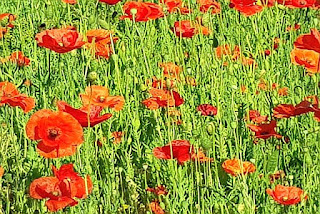 |
| Grave marker at the American Cemetery at Omaha Beach in Normandy honoring Theodore Roosevelt, Jr who landed at Utah Beach on D-Day (Photo: Taylor) |
BELGIUM & FRANCE —.For travelers to the sites of
the two World Wars, there are countless
memorials, cemeteries and museums which serve to commemorate those who
sacrificed their lives to preserve our freedoms.
Two of
the most powerful memorials, one from each of the World Wars, are solemn expressions
that we should visit to remind us of the horrors and insanity of the conflicts
of mankind.
 |
| The Brooding Soldier at St. Julien Memorial Park in Belgium where Germany used gas for the first time in war in 2015 (Courtesy: battlefieldsbelgium.be) |
The
first is the St. Julien Memorial in the northeast sector of the Ypres
Salient in Belgium
The
memorial is a small park situated in the village
of Saint-Julien , Langemark , Belgium
 |
| Plaque denoting use of gas warfare in 1915 (Photo: Nancy W Beach -- Creative Commons Attribution Share Alike 4.0 International license) |
As with
so many things that capture our imagination, the "Brooding Soldier" sculpture
by Frederick Chapman Clemsha is sobering, haunting, powerful and, yet uplifting
in its simplicity. The 36-foot monument was the result of a design competition
by the Canadian Battlefield Monument Commission in 1920. Today, it serves as
the focal point of the memorial park.
On April
22, 1915 the German army advanced with 168 tons of chlorine gas contained in
nearly 6,000 cylinders buried in their trenches north of Ypres .
Canadian troops who had been at the scene only a few days to protect the lines
southwest of St. Julien became the victims of the first poison gas attack on
the Western Front.
A north
wind carried the initial gas attack to the north and west of Canadian lines and
into the trenches of French colonial troops. After witnessing the early
casualties, the French abandoned their trenches creating an 8,000 yard gap in
the Allied line.
 |
| The Brooding Soldier is a powerful reminder of the horrors and destruction of war (Photo: LB Marshall -- Creative Commons Attribution Share Alike 4.0 International license) |
Fortunately,
the drifting gas also affected German infantry positions. Without reinforcements,
the Germans were unable to exploit the break, allowing Canadian and French
forces to hastily regroup their defenses.
While
holding the line for two days, 6,035 Canadian soldiers were casualties,
representing one man in every three who went into battle. Approximately 2,000
of those 6,000 troops perished in the
fighting.
 |
| Poppies are the symbol of' Flanders (Photo: Taylor) |
In
tribute, the Canadian Memorial is an example of landscape architecture at its
finest.
Visible
for miles around, "The Brooding Soldier" column rises from a circular
flagstone terrace. It is sculpted at the top to form the bowed head and
shoulders of a Canadian soldier whose hands are resting on the butt of his
down-turned rifle in the "arms reversed" position.
 |
| Entrance to Brooding Soldier Memorial (Photo: (Zeisterre -- Creative Commons Attribution Share Alike 3 Unported license) |
This traditional
pose is used as gesture of mourning and respect for the fallen performed at
funerals and services of remembrance in Canada
Surrounding the column and central terrace are
gardens of tall cedars trimmed in the shape of artillery shells with low cut
cedars representing shell explosions.
To the
right of the memorial, other low cut foliage symbolizes the encroachment of the
drifting gas.
 |
| The Brooding Canadian Memorial is both somber and poignant (Courtesy: WWIcemeteries.com) |
Some of
the soil nourishing the gardens was brought from various locations across Canada
The
memorial at Saint Julien was unveiled on July 8, 1923.
 |
| Spirit of American Youth Rising from the Waves at the Normandy American Cemetery (Photo: Taylor) |
Nearly
three decades later, following the Second World War, Donald Harcourt De Lue was
commissioned to create seven works for a memorial to the fallen soldiers of
D-Day located on Omaha Beach in Normandy , France
The most
famous work is the celebrated spiritual centerpiece sculpture of the Normandy American Cemetery
 |
| View of Omaha Beach from the overlook (Photo: Taylor) |
Where
the "Brooding Soldier" of Canada
Cast in Milan
"MINE
EYES HAVE SEEN THE GLORY OF THE COMING OF THE LORD"
 |
| The markers face in the direction of the United States (Photo: Taylor) |
To the
right of the 9,387 crosses, Stars of David and the statue is an overlook with a
view down and across the bluffs to the massive expanse of beach terrain the
troops had to negotiate on D-Day.
Standing
at the promontory, it is nearly unfathomable to comprehend the bravery of the
young men who fought and died there. It is unimaginable to ponder how they
managed to succeed against such overwhelming odds.
This is
the tribute that De Lue so masterfully captures in his bronze memorial at the American Cemetery
at Omaha Beach.
 |
| Omaha Beach as it appeared on D-Day (Photo: Public Domain) |
Travelers to Europe should experience many of these sites during their journeys in order to to appreciate the full measure and magnitude of the sacrifices made by so many; the Anne Frank House, Dachau and Auschwitz, the World War I trenches, Flanders Fields and the Normandy American Cemetery to mention a few.
And
while you're at it, you will quickly discover it is impossible to view the
"Brooding Soldier" and the "Spirit of American Youth" without
shedding a tear and quietly saying "Thank you."







0 comments:
Post a Comment